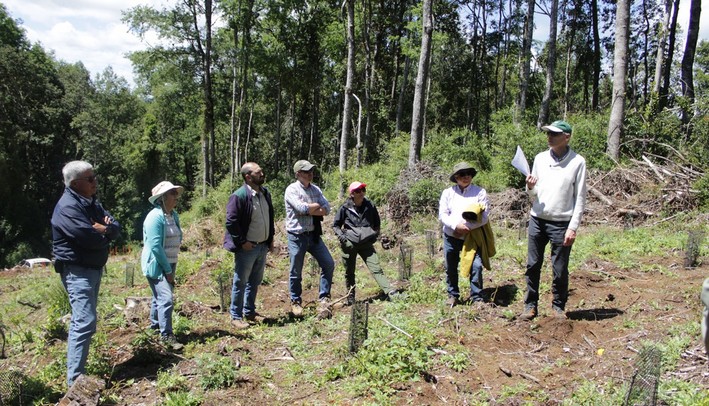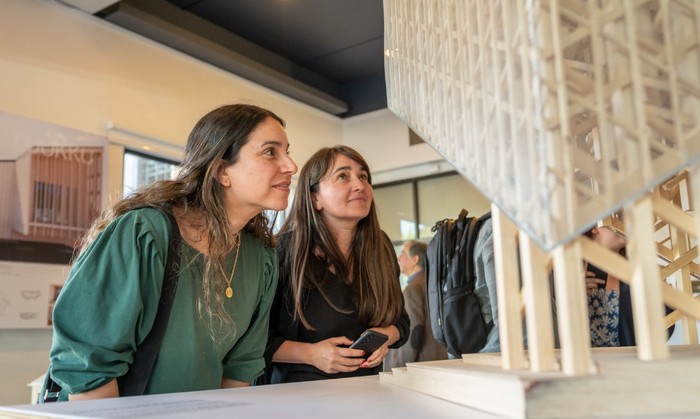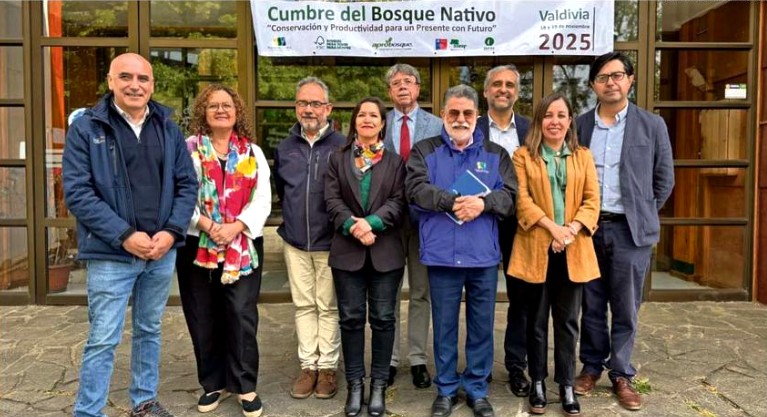Hybrid Oak-Raulí Trees Generated to Diversify the Forestry Industry
The closing ceremony of the FIC-R project "Development and Technological Scaling of Oak x Raulí Hybrids" was held with a presentation and a site visit to see the oak-raulí hybrid trials firsthand. This initiative was funded by the Regional Innovation Fund for Competitiveness (FIC-R) of the Regional Government of Los Ríos and its Regional Council, promoted by the Regional Productive Development Corporation, and executed by the Austral University of Chile.
The event took place at the Chalet of the Santa Rosalía Estate, where welcoming remarks were given by Alejandra Pugin, executive of the Regional Productive Development Corporation, and host Cristian Mattausch. Subsequently, greetings were delivered by Marcos Flores, Acting Director of CONAF, and finally, the Governor of the Los Ríos Region, Mr. Luis Cuvertino, addressed the attendees, highlighting the project's positive aspects and indicating that the Regional Government wishes to continue supporting this line of work to consolidate its large-scale application in the Region and throughout southern Chile.
"We see great prospects in this project; personally, I believe it marks a significant turning point in forest policy. This work has achieved, after many years, a product such as this oak-raulí hybrid, which has great potential, and we hope it scales up as soon as possible," stated the regional authority.
The Regional Ministerial Secretary of Agriculture, Jorge Sánchez, also attended the event and valued the activity. "It provides us with clear and visible background through these two project lines that have been developed with the FIC. We hope to have continuity in forest genetics matters to evaluate basal diameters in the future and, of course, the quality of raulí for seeking new markets, an issue we are working on strongly in the Forest Industry Promotion Roundtable of our Los Ríos Region," he explained.
The project director and academic from the Faculty of Forest Sciences and Natural Resources at UACh, Dr. Fernando Droppelmann, explained that the crossbreeding between the native species of oak and raulí aims to combine the best attributes of both. "In this case, oak has a wide capacity to grow in different site conditions, and on the other hand, raulí has a very good growth habit and spectacular wood properties," he noted.
Trial Visits
Afterwards, the group proceeded to the Catrico and Roblería Estates, where they could observe the growth of the hybrids and analyze their development under different conditions and ages.
"At the Catrico estate, a clonal trial planted in July 2025 was presented, and the silvicultural conditions under which this trial will develop were observed," indicated Dr. Droppelmann.
Later, a clonal trial at the Roblería property belonging to Forestal Arauco was visited. There, the Zonal Sub-manager, Carlos Oettinger, welcomed the attendees, expressing the company's commitment to this line of work.
"Here we observed the development of various very interesting hybrids. The attendees were impressed by the growth and quality that this material is showing. There is no doubt that it is becoming a real option for high-productivity afforestation with a native species," highlighted Dr. Droppelmann.
In Search of High-Productivity Trees
Although the closure of this project has achieved significant progress, the UACh researcher is clear in stating that there is still work to be done. "We must continue taking very important steps, and for that reason, we wish to carry out a third stage, and hopefully a fourth, so that we can amplify the genetic base of these hybrids. Because the more material we have, the greater the number of high-productivity and high-quality hybrids we can obtain, and that is a rather lengthy task," he indicated.
On the other hand, he added, "we must improve the propagation systems. We have a tested propagation system, but there is considerable room for improvement, which means significantly reducing plant production costs. Finally, there is a very important point related to the evaluation of all the trials that have been planted. There is a network of clonal trials with different establishment ages; the oldest are 7 years old, and this year, 6 new trials were incorporated. All of these must be measured in terms of growth, quality—that is, their form and branch quality—and also wood properties. This last evaluation cannot be done at very early stages; therefore, it is something that will take us several years ahead."
















